US durable goods orders rose 3.2% mom to USD 276.4B in March, well above expectation of 0.8% mom. Ex-transport orders rose 0.3% mom to USD 179.0B, above expectation of -0.2% mom. Ex-defense orders rose 3.5% mom to USD 259.3B. Transportation equipment rose 9.1% mom to USD 97.4B.
Germany Gfk consumer sentiment rose to -25.7, improved economic and income expectations
Germany Gfk Consumer Sentiment for May improved from -29.3 to -25.7, above expectation of -27.5. In April, Economic Expectations rose sharply from 3.7 to 14.3. Income Expectations rose from -24.3 to -10.7. Propensity to Buy rose from -17.0 to -13.1.
The seventh increase in a row indicates that consumer sentiment is gathering momentum. “Following a rather small increase in the previous month, consumer sentiment is showing clear signs of an upswing this month,” explains Rolf Bürkl, GfK consumer expert.
“However, the value still remains below pre-pandemic levels of around three years ago. On another positive note, income expectations have risen for the seventh time in a row, returning to the level prior to the start of the war in Ukraine for the first time.”
Australia CPI down to 7.0% yoy in Q1, 6.3% yoy in Mar
Australia CPI slowed from 7.8% yoy to 7.0% yoy in Q1, slightly above expectation of 6.9% yoy. For the quarter, CPI rose 1.4% qoq, down from prior 1.9% qoq, below expectation of 1.3% qoq. Trimmed mean CPI rose 1.2% qoq, 6.6% yoy while weighted median CPI rose 1.2% qoq, 5.8% yoy.
Michelle Marquardt, ABS head of prices statistics, said “CPI inflation slowed in the March quarter, with the quarterly rise being the lowest since December 2021. While prices continued to rise for most goods and services, many of these increases were smaller than they have been in recent quarters.”
Monthly CPI slowed from 6.8% yoy to 6.3% yoy in March, below expectation of 6.5% yoy. Excluding volatile items (Fruit and vegetables and Automotive fuel) CPI, rose from 6.8% yoy to 6.9% yoy.
Full Australia quarterly CPI release here, and monthly CPI release here.
NZ imports surged 10% yoy, export rose 0.6% yoy in Mar
Australia contributed the most to the growth in monthly exports, with a 30% rise. Goods exports to the US was up 4.1%, EU up 28%, but down -9.6% to Japan and down -5.7% to China.
On the other hand, imports from the US leads the monthly rise, up 39%. Imports from EU and South Korea grew 24% and 20% respectively. On the other hand, imports from China was down -13%, Australia down -4.0%.
BoJ Ueda: Dealing with cost-push inflation is very difficult
In an address to parliament today, BoJ Governor Kazuo Ueda highlighted the difficulties central banks face when dealing with cost-push inflation.
Ueda explained, “In general, dealing with cost-push inflation is very difficult for central banks. On the one hand, you’d like to curb inflation. On the other hand, you don’t want to tighten monetary policy knowing that cost-push inflation will cool the economy.”
The governor emphasized the importance of striking the right balance, which he said, “depends on economic developments at the time, including where inflation stood at the outset.”
Ueda also noted that cost-push inflation in Japan is likely to ease as prices of imported raw materials have probably peaked.
These comments come ahead of BoJ’s two-day policy meeting starting on Thursday, during which the central bank is widely anticipated to maintain its ultra-loose monetary policy.
BoE Pill: We’ve had a series of transitory inflation shocks one after the other
In an interview on the “Beyond Unprecedented” podcast produced by Columbia University’s law school, BoE Chief Economist Huw Pill reiterated the central bank’s official forecast, stating that some factors maintaining high inflation are likely to recede in the upcoming months and that inflation could fall below the 2% target in the next few years.
Discussing the continuous inflationary shocks faced by the UK, Pill said, “We’ve had a series of inflation shocks that just come one after the other.” He added, “Each of those shocks was in itself transitory, but they just were timed in a way that inflation never dissipated.”
Pill emphasized the need for UK citizens to accept being worse off and to refrain from trying to maintain their real spending power by driving up prices through higher wages or passing on energy costs to customers. Pill observed, “What we’re facing now is that reluctance to accept that, yes, we’re all worse off and have to take our share.”
He also highlighted the UK’s status as a major net importer of natural gas and the resulting challenges, noting, “The UK, which is a big net importer of natural gas, is facing a situation that the price of what you’re buying from the rest of the world has gone up a lot, relative to the price of what you’re selling to the rest of the world, which is mainly services in the case of the UK.”
Pill concluded, “If what you’re buying has gone up a lot relative to what you’re selling, you’re going to be worse off.”
US consumer confidence fell to 101.3, consumer inflation expectations essentially unchanged
US Conference Board Consumer Confidence fell from 104.0 to 101.3 in April, below expectation of 104.1. Present Situation Index rose from1 48.9 to 151.1. Expectations Index dropped from 74.0 to 68.1. The Expectations Index has now remained below 80—the level associated with a recession within the next year—every month since February 2022, with the exception of a brief uptick in December 2022.
“While consumers’ relatively favorable assessment of the current business environment improved somewhat in April, their expectations fell and remain below the level which often signals a recession looming in the short-term,” said Ataman Ozyildirim, Senior Director, Economics at The Conference Board.
“Consumers became more pessimistic about the outlook for both business conditions and labor markets. Compared to last month, fewer households expect business conditions to improve and more expect worsening of conditions in the next six months. They also expect fewer jobs to be available over the short term. April’s decline in consumer confidence reflects particular deterioration in expectations for consumers under 55 years of age and for households earning $50,000 and over.”
“Meanwhile, April’s results show consumer inflation expectations over the next 12 months remain essentially unchanged from March at 6.2 percent—although that level is down substantially from the peak of 7.9 percent reached last year, it is still elevated. Overall purchasing plans for homes, autos, appliances, and vacations all pulled back in April, a signal that consumers may be economizing amid growing pessimism.”
Aussie down broadly following free fall in Copper
Australian Dollar is trading broadly lower today, even against New Zealand Dollar. Risk sentiment isn’t much of a factor contributing to selloff considering that major European indexes are just in slight decline. Instead, the free fall in copper price might be a larger factor. But for sure, some traders could have jumped out of Aussie ahead of tomorrow’s CPI release too, which is crucial to RBA rate decision on May 2, i.e., next Tuesday.
As for Copper, the fall from 4.1743 is accelerating notably today. Deeper decline is expected as long as 3.3974 resistance holds, to 3.8229 support and below. Price structures from 4.3556 (Jan high) are so far corrective looking. Hence, strong support should emerge ahead of 100% projection of 4.3556 to 3.8229 from 4.1743 at 3.6416 to complete the correction, and bring sustainable rebound. However, sustained break of 3.6416 could risk more downside acceleration back towards 3.1314 (2022 low).
AUD/NZD’s steep fall from 1.0928 and firm break of 55 4H EMA indicates short term topping. It also raises the chance that whole rebound from 1.0585 has completed. Deeper decline is now in favor to 1.0732 support. Firm break there will pave the way back to 1.0585. Also, it’s a bit early to determine, but fall from 1.0928 could also be the third leg of the pattern from 1.1085. Hence, any downside acceleration would push AUD/NZD back to 1.0469 low easily.
ECB Lane: Inappropriate to leave deposit rate at current 3%
ECB Chief Economist Philip Lane revealed in an interview with French newspaper Le Monde that the central bank will likely raise interest rates again at their May 4 meeting, stating, “This is still not the right time to stop.” While Lane did not specify the rate hike’s magnitude, he said that “it would be inappropriate to leave our deposit rate at the current level of 3%.”
Lane acknowledged the decline in Eurozone inflation from 10.6% last October to 6.9% in March as a positive development, easing pressure on living costs. He expects inflation to continue falling due to supply chain bottleneck improvements and the reversal of the energy situation. However, Lane stressed that the most crucial aspect for central banks is “making sure that we get close to our target of 2% within a reasonable time period.”
Lane does not believe the current situation resembles the 1970s-style persistent inflation, but he cautioned against the risk of ending up in such a scenario. Lane underlined the importance of ECB raising interest rates to ensure a “timely” return to the 2% inflation target. Regarding the European economy, he noted that while it is not stagnant, it follows a more modest path than expected prior to the pandemic and the Russian war against Ukraine.
EUR/AUD, EUR/CAD, GBP/AUD, GBP/CAD uptrend resumptions
Both Euro and Sterling have made significant gains against Australian and Canadian Dollars this week, resuming medium-term uptrends in respective crosses. Overnight comments from a top ECB official suggest that a 50bps rate hike may be on the table for May policy meeting. Meanwhile, recent UK data underscores the necessity for BoE to extend its tightening measures in order to combat persistently high, double-digit inflation.
On the other hand, there is no data supporting a shift from BoC’s current pause in rate hikes. Australian dollar appears vulnerable ahead of tomorrow’s crucial CPI release, which will likely determine whether RBA will implement a final rate hike in the current cycle.
EUR/AUD’s up trend from 1.4281 is now in progress for 100% projection of 1.4281 to 1.5976 from 1.5254 at 1.6949. Near term outlook will stay bullish as long as 1.6219 support holds, in case of retreat.
EUR/CAD’s break of 1.4935 confirmed resumption of whole up trend from 1.2867. Immediate target is 61.8% projection of 1.3270 to 1.4640 from 1.4236 at 1.5083. Sustained break there could prompt upside acceleration to 100% projection at 1.5606. Meanwhile, outlook will stay bullish as long as 1.4261 support holds, in case of retreat.
GBP/AUD’s breach of 1.8697 resistance argues that uptrend from 1.5925 is resuming. Outlook will stay bullish as long as 1.8393 support holds, in case of retreat. Sustained trading above 61.8% projection of 1.5925 to 1.8272 from 1.7218 at 1.8668 could prompt upside acceleration to 1.9218 resistance and then 100% projection at 1.9565.
GBP/CAD’s break of 1.6846 resistance also indicates resumption of up trend from 1.4069. Near term outlook will stay bullish as long as 1.6535 support holds. Current rise should target 61.8% projection of 1.4069 to 1.6846 from 1.6075 at 1.7791 next.
BoJ Governor Ueda stresses need for continued monetary easing
BoJ BOJ Governor Kazuo Ueda addressed parliament today, emphasizing, “In light of current economic, price and financial developments, it’s appropriate to maintain monetary easing, now conducted through yield curve control.”
Ueda reiterated the importance of keeping Japan’s monetary policy loose to achieve the 2% inflation target in a sustainable and stable manner, along with wage hikes. He added that if wage growth and inflation accelerate faster than expected and require tightening monetary policy, BoJ is prepared to respond by raising interest rates.
Despite this, Ueda warned of the risk of inflation falling further below expectations, calling it “very worrying.” He noted that “the risk of inflation undershooting forecasts is bigger than the risk of overshooting,” emphasizing the need to maintain the BoJ ‘s massive stimulus for the time being.
ECB’s Makhlouf: Too early to start planning for a pause
ECB Governing Council member Gabriel Makhlouf stated in a blog post that it is too early to plan for a pause in tightening of monetary policy, emphasizing the need to focus on incoming data. In a blog post, Makhlouf said, “on the evidence so far, it is too early to start planning for a pause in our tightening of policy.” He further noted that based on current evidence, restrictive rate levels are necessary to balance supply and demand in the economy and reduce inflation.
In separate occasion, another Governing Council member François Villeroy de Galhau emphasized the role of climate change in affecting price stability and economic activity. He highlighted that addressing climate change is not an instance of mission creep or politicization, but rather a core duty of central banks worldwide. Villeroy stated, “It’s not mission creep, it’s not a politicisation of our mandate – it is our core business and core duty.”
ECB’s Schnabel: Further rate hikes needed, 50 not off the table
ECB Executive Board member Isabel Schnabel said in a Politico interview that additional rate hikes are necessary, with the size of these hikes depending on incoming data. “The data we have so far shows that inflation is higher and the economy more resilient than projected,” she added that “data dependence means that 50 basis points are not off the table” for May meeting.
She also noted that “it’s far too early to declare victory on inflation.” She explained that if core inflation remains high and persistent, even if it reaches a peak, the information content of that data point might be limited. “So what we really need is confidence that it’s actually coming down in a sustained manner.”
Schnabel acknowledged that she cannot predict the terminal interest rate, noting that rates must be set on a meeting-to-meeting basis. She also addressed concerns about a potential recession, stating, “So far, there are no particular signs of a weakening in economic developments. At this point in time, I have no reason to believe that a recession is coming.”
Bundesbank: Inflation to remain high overall in coming months
In its latest monthly report, Bundesbank revealed that German economy performed better than anticipated in the first quarter of 2023. Despite persistently high inflation negatively impacting private consumption, industry experienced a stronger recovery. Additionally, goods exports saw a sharp increase, and construction industry temporarily boosted production. Improved economic performance during the winter months was also reflected in the labor market. Early indicators suggest further positive developments ahead.
Inflation rate fell notably to 7.8% in March, a 1.5 percentage point decrease from February. Bundesbank attributes this decline to a base effect. However, core inflation rate, excluding energy and food, climbed by 0.5 percentage points to reach a historic high of 5.9%. In the coming months, Bundesbank expects inflation rate to continue falling somewhat, particularly due to decreasing energy prices and a potential gradual easing in prices of food, other goods, and services. However, underlying price pressure is expected to remain high overall in the coming months.
Germany Ifo rose to 93.6, worries abating, but lacks dynamism
Germany Ifo Business Climate rose slightly from 93.2 to 93.6 in April, below expectation of 94.0. Current Assessment index dropped from 95.4 to 95.0, below expectation of 96.1. Expectations index rose from 91.0 to 92.2, above expectation of 91.6.
By sector, manufacturing rose from 6.5 to 6.7. Services dropped from 8.8 to 6.8. Trade dropped from -10.1 to -10.7. Construction rose from -17.5 to -16.7.
Ifo said: “German business’s worries are abating, but the economy is still lacking dynamism.
ECB’s Wunsch awaits core inflation and wage growth to come down
In an interview with Financial Times, ECB Governing Council member Pierre Wunsch mentioned that the central bank is waiting for both wage growth and core inflation to decrease in conjunction with headline inflation before considering a pause.
Wunsch stated, “I would not be surprised if we had to go to 4 percent at some point.” He emphasized that ECB aims for a soft landing, and “nobody is going to err on the side of destroying the economy for the sake of destroying the economy.”
“But I have absolutely no indication that what we are doing (on interest rates) is too much,” he added.
Regarding rate hikes, Wunsch clarified, “I’m not a fetishist. I’m not going to hike rates even in a recession just because we have 2.3 percent or 2.1 percent inflation in the two-year forecast. But I’m not seeing inflation numbers going in the right direction yet.”
He also pointed out that if wage agreements persist around a 5 percent growth for an extended period, inflation may not return to 2 percent on a structural basis.
BoJ Ueda highlights importance of strong inflation projections in monetary policy decisions
BoJ Governor Kazuo Ueda emphasized today that the central bank’s inflation forecasts must be “quite strong and close to 2%” within the coming year for the bank to consider adjusting its yield curve control policy.
Speaking to parliament, Ueda said that as “trend inflation is below 2%,” BoJ must maintain its current monetary easing stance. However, he noted that when trend inflation is projected to reach 2% target, the central bank must normalize monetary policy.
When asked about the specifics of how BoJ might phase out YCC, Ueda opted not to provide explicit details, clarifying that such a decision would hinge on a variety of factors, encompassing the economy, inflation pace, and other elements at the time of the verdict.
“At this moment, I cannot provide a definitive answer regarding how this could be executed,” he said, touching upon BoJ’s exit strategy. Nonetheless, Ueda reassured that ” BOJ has actively been conducting numerous evaluations on the potential impact of a monetary policy normalization on its financial situation.”
Bitcoin in tight range as super cycle chat continues
In today’s Asian trading session, Bitcoin was navigating a rather narrow trading range, as it tries to lean on 55 D EMA for support. Just earlier this month, Bitcoin climbed up to 31,011, staging a comeback from last year’s low of 15,452. Yet, the momentum has since waned, as it turned into a pullback. While the overall momentum of bitcoin isn’t too convincing, there are market whispers about the start of a new “super cycle.”
This super cycle conjecture is rooted in the anticipation of the “halving” event, which is predicted to take place around April 2024. The total supply of Bitcoin is capped at 21 million (hardcoded into the protocol by creator Satoshi Nakamoto). The halving event cuts the rate at which new bitcoins emerge and are awarded to miners, approximately every four years or after 210,000 blocks have been mined.
When Bitcoin was first launched in 2009, the block reward was 50 bitcoins. In 2012, the first halving transpired, slashing the reward to 25 bitcoins. Fast forward to 2016, and the reward was reduced once more, this time to 12.5 bitcoins. The latest halving took place in May 2020, leaving the current block reward at a modest 6.25 bitcoins.
Historically, Bitcoin has experienced significant price movements following halving events. In each cycle, the cryptocurrency’s price bottomed out around 12-18 months before the halving, followed by a new record high in the subsequent months.
From a technical perspective, near term outlook of Bitcoin will remain bullish as long as 25242 resistance turned support holds, even in case of deeper pull back. Break of 31011 will resume the rebound from 15452 to 38.2% retracement of 68986 to 15452 at 35902. This is the key hurdle for Bitcoin to overcome if it’s really developing into a “super cycle” up trend.
Meanwhile, decisive break 25242 support will argue that Bitcoin is vulnerable to hit another low below 15452 before building the base for the so-called “super cycle”.
Canada retail sales down -0.2% mom in Feb, smaller than expected
Canada retail sales contracted -0.2% mom to CAD 66.3B in February, better than expectation of -0.6% mom. Sales decreased in 4 of 9 subsectors, representing 48.0% of retail trade. The decrease was led by lower sales at gasoline stations and fuel vendors (-5.0%) and general merchandise retailers (-1.6%).
Core retail sales—which exclude gasoline stations and fuel vendors and motor vehicle and parts dealers—increased 0.1% mom.
In volume terms, retail sales decreased -0.7% mom in February.
Advance estimate suggests that sales decreased another -1.4% mom in March.




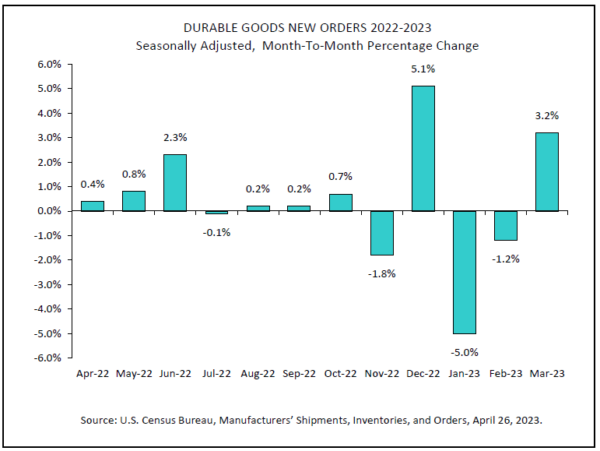
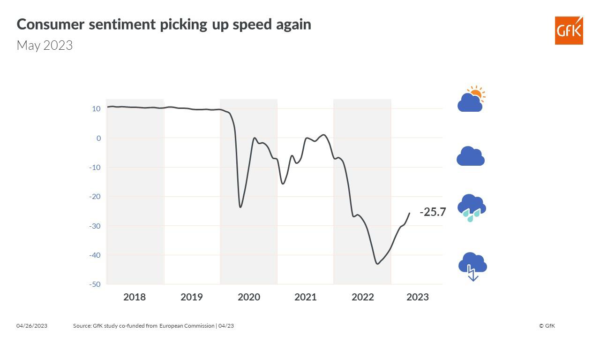
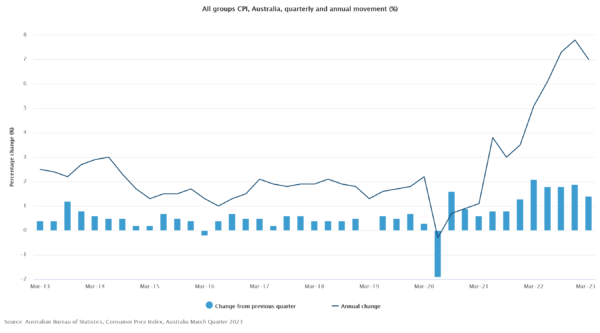

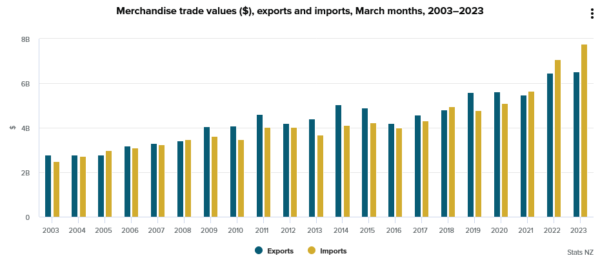

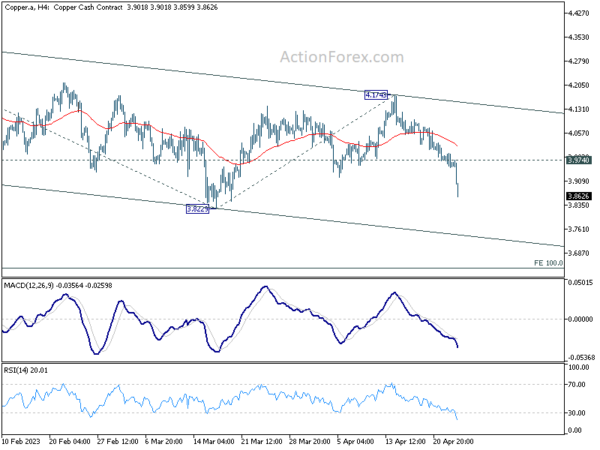
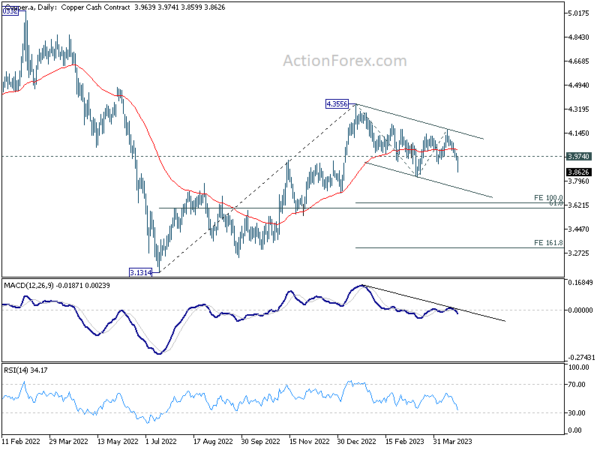
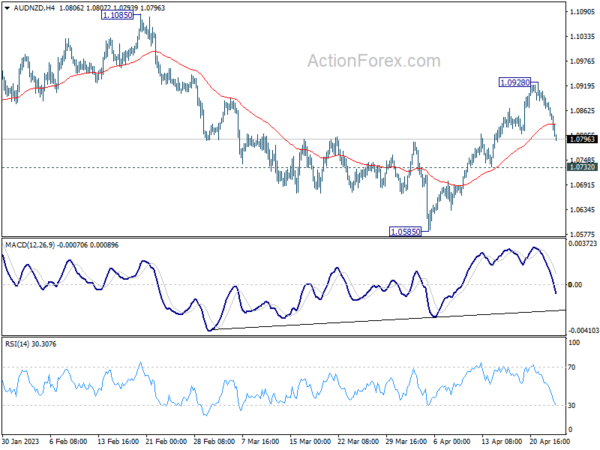
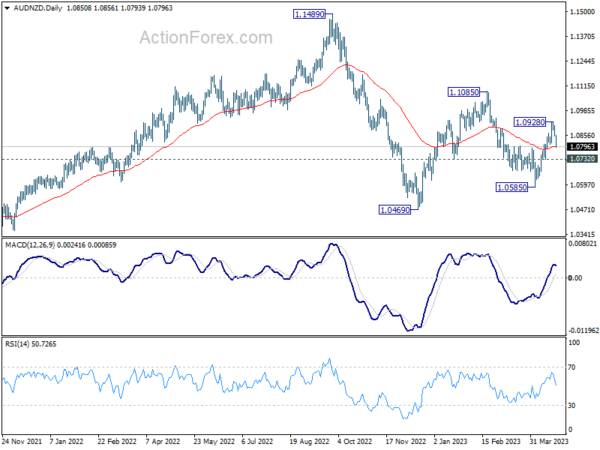
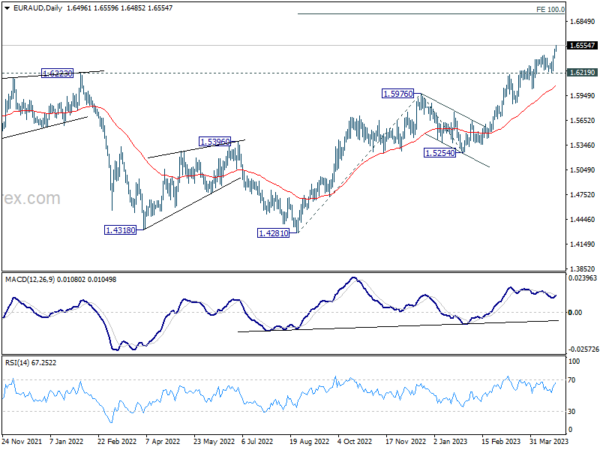
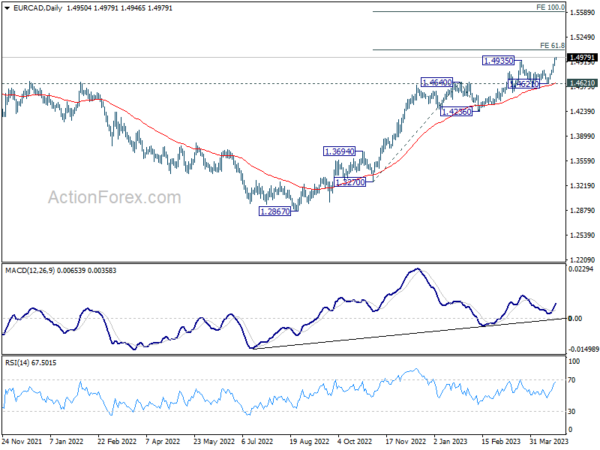
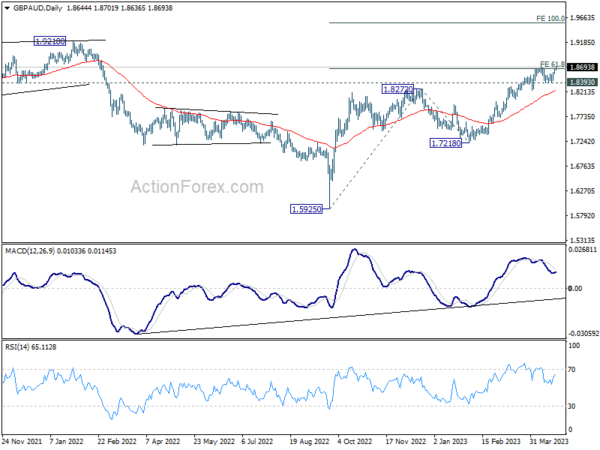
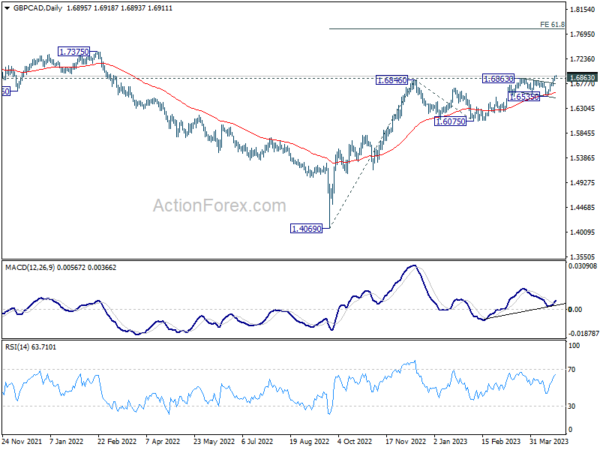
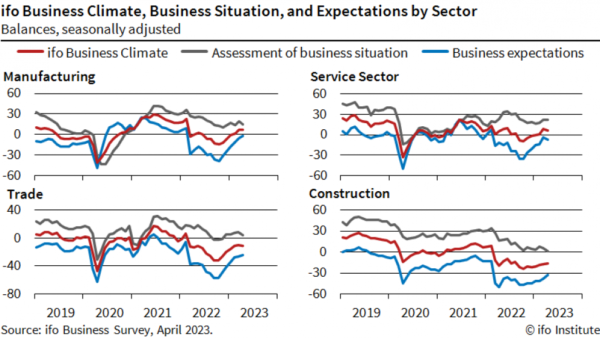
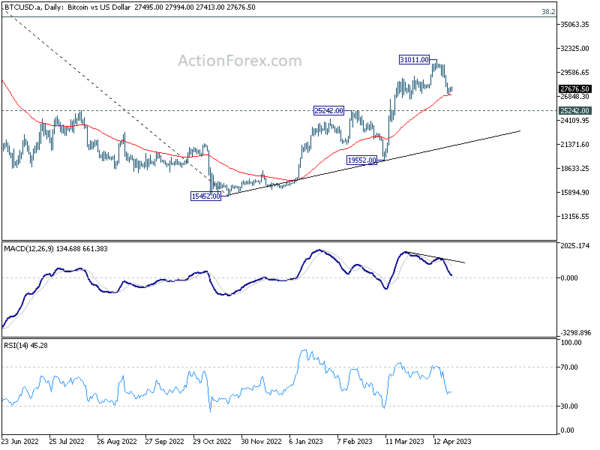
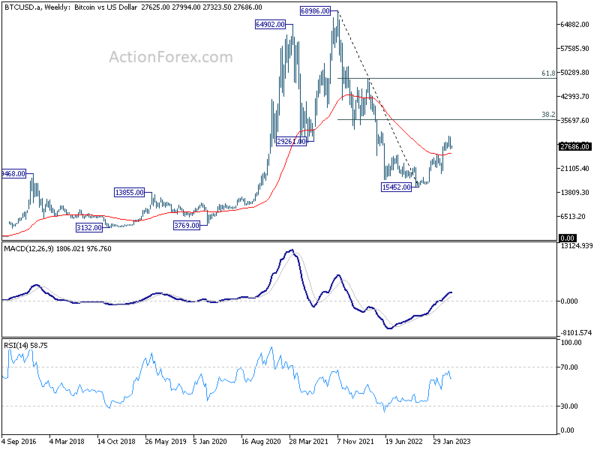
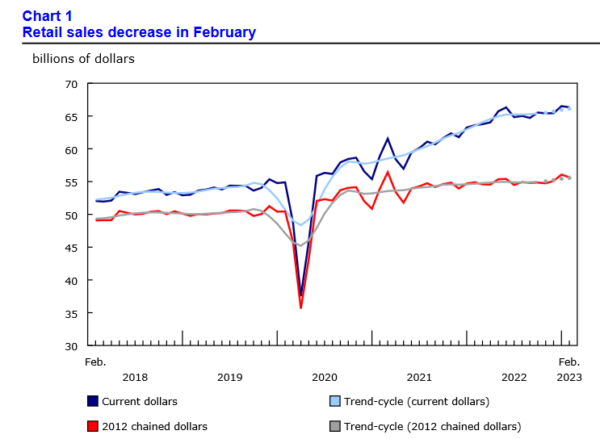

US goods trade deficit narrowed to USD -84.6B in Mar
US goods exports rose USD 4.9B to USD 172.7B in March. Goods imports dropped USD -2.5B to 257.3B. Trade deficit came in at USD -84.6B, smaller than expectation of USD -89.8B.
Wholesale inventories rose 0.1% mom to USD 919.9B. Retail inventories rose 0.7% mom to USD 773.4B.
Full US goods trade balance release here.